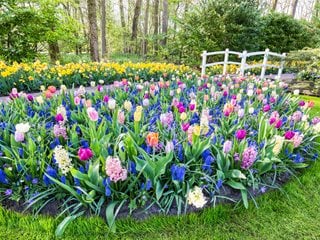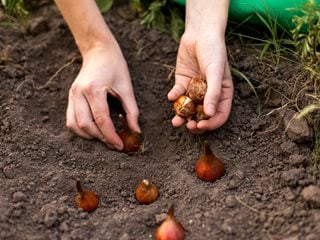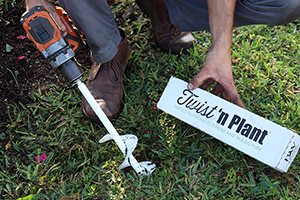Zone 9 Bulbs Planting for Continuous Blooms

Photo by: Ben Schonewille / Shutterstock.
Bulbs are little packets of flower power that make us wait weeks, sometimes months, for results — but boy, are they worth it. The term "bulb" often refers not only to true bulbs, but also plants with tuberous roots, tubers, corms, and rhizomes; the information here can be applied to all of these. With a little basic knowledge, anyone can grow beautiful bulbs.
On this page:
- TYPES OF BULBS
- PLANTING BULBS
- DIGGING & STORING BULBS
- HELPFUL HINTS
- BUYING BULBS
TYPES OF BULBS
Bulbs can be separated into two main types: spring and summer.
Spring bulbs: Also called hardy bulbs, these bulbs are planted in fall, spend winter in the ground, and flower in spring. Some of the more common spring bulbs are tulips, irises, daffodils, hyacinth, allium and crocus. These bulbs need several weeks of cold temperatures to break their dormancy and flower to their full potential. (See more: Spring Bulbs.)
Summer bulbs: Also called tender bulbs, these bulbs are planted in spring and flower or leaf out in summer. Gladiolus, lilies, caladiums, and elephant ears are common examples of summer bulbs. Some will bloom later in summer or for a longer time, like dahlias that bloom into fall. (See more: Summer Bulbs.)
Summer bulbs aren't tolerant of cold temperatures and should only be planted after the ground warms up and there's no longer a threat of frost. If purchased before planting time, store them in a cool, dry spot until planting.
PLANTING BULBS
WHEN TO PLANT BULBS
Zones 4 to 7: In colder climates, spring-flowering bulbs can be planted as soon as the ground is cool, evening temperatures average 40° to 50°F, and it is at least 6 to 8 weeks before the ground freezes. If timed right, this should be as soon as possible after purchase. However, bulbs can be stored in the refrigerator if needed until planting. (See Helpful Hints below for more information on storing bulbs in the refrigerator.)
Summer-flowering bulbs should be planted in mid to late spring.
Zones 8 to 10: In warmer climates, spring-flowering bulbs will need to be chilled in the refrigerator for 6 to 10 weeks (depending on the bulb) until the ground cools enough for planting. (See Helpful Hints below for more information on storing bulbs in the refrigerator.)
Summer-flowering bulbs can be planted early to mid-spring.

Photo by: Olga Ponomarenko / Shutterstock.
Average planting times for spring bulbs:
- September to October — Zones 4 and 5
- October to early November — Zones 6 and 7
- November to early December — Zones 8 and 9
- Late December to early January — Zone 10
Average planting times for summer bulbs:
- Late March to May — Zones 8 to 10
- May to June — Zones 4 to 7
WHERE TO PLANT BULBS
As long as you ensure that your bulbs have good drainage and sunlight, you can plant them just about anywhere. Drainage is critical to keep bulbs from rotting. They like loamy or slightly sandy soil because it provides the drainage and nutrients they need.
Early-spring bloomers can be planted under deciduous trees where they'll get enough sun to bloom before the tree's leaves block out the light. However, they'll only bloom well the first year, as they'll need sunlight later in the season for the leaves to gather enough energy for next year's flowers.
PLAN BEFORE YOU PLANT
Bulbs can be grown in many ways — formal gardens, meadow gardens, scattered in lawns, under trees, or strategically planted throughout beds and borders. Many bulbs will naturalize in an area and multiply, coming back year after year, so plan carefully and you can have years of enjoyment from one planting.
- Plant in clusters for greater visual impact.
- Take into account bloom time — plant a combination of early, mid- and late-season bloomers to extend the season.
- Hide dying foliage of low-growing bulbs that are past their prime with taller bulbs planted in front or with companion plants.
- Layer plant heights from front to back when planting varieties that will bloom at the same time.
- Many bulbs are perfect for container planting — bring them into view when blooming and move out of the way when foliage is wilting and when dormant. Plant closer together in containers than specified for in-ground planting.
- Bulbs can provide bright, vibrant color — think about how those colors will blend with their surroundings.
- Companion plants keep the planting area going when bulbs are dormant. Some good perennial companions are sedum, coreopsis, thyme, cranesbill, daylilies, coral bells, brunnera, hosta, hellebores, or bleeding heart.
HOW TO PLANT BULBS
Bulbs can be planted in layers by digging up an entire area down to the proper depth, placing the bulbs and covering; or in individual holes dug for each bulb. Individual planting is made easier with a bedding plant auger (pictured).

Twist 'n Plant gardening auger. Photo by: Proven Winners.
- Determine the planting depth for the type of bulb you're planting. If planted too deep, flowers will bloom late or not at all. If planted too shallow, new growth may become exposed too soon and risk damage by cold temperatures. If you are unsure of the exact planting depth, a good general rule of thumb is to plant the bulb 2 to 3 times as deep as the bulb is tall.
- Prepare the soil by loosening and mixing in organic material if needed for added nutrients or to improve drainage. Special bulb fertilizer can be added; follow the package directions.
- Place the bulbs with the pointy-end up and with the roots down. If you're not sure of the top or bottom of the bulb, plant it on its side and it will find its way to the surface.
- Cover with soil and a light layer of mulch.
- Newly planted bulbs should be watered well to get settled in.
- If needed, protect bulbs from critters by staking down wire mesh or chicken wire over the beds or planting them in bulb baskets or wire cages.
LASAGNA PLANTING
Not only good for Sunday dinner, lasagna (planting) is great for bulbs. The idea is to plant bulbs with different sizes and staggered bloom times in layers for a continual bloom. This works great in large containers that are deep and wide enough. Here's a sample plan, working from the bottom up in a container:
Planting a Layered Bulb Pot
- A good layer of potting soil for a planting depth of about 8 inches
- A few late-spring-blooming bulbs such as daffodils or tulips
- Another layer of potting soil for a planting depth of about 6 inches
- Add mid-spring-blooming bulbs such as more tulips or hyacinth
- Another layer of potting soil for a planting depth of about 4 inches
- Add early-blooming bulbs such as galanthus, scilla, muscari or crocus
- Another layer of potting soil for a planting depth of about 2 inches
- Add more early-blooming bulbs such as freesia or anemones
- Top with more potting soil and a thin layer of mulch
- Overplant with pansies, heuchera, hardy cyclamen or dusty miller if you'd like a filler while waiting for the bulbs to grow.
This planting method can be used in-ground as well for a concentrated area planting. It can also be adjusted to fewer layers in smaller pots.
AFTER-CARE AND DIGGING UP BULBS
For all bulbs, after blooming, cut only the flower stem back. Leave foliage intact until it turns yellow and wilts to the ground; the leaves are gathering and storing energy for next year. If the foliage is cut back too soon, bulbs may not perform well—or at all—the following year.
Spring bulbs: In warmer climates bulbs that require chilling can be dug up and stored until pre-chilling time the following fall. For colder climates, they can stay in the ground. Many will multiply and return year after year.
Summer bulbs: In warmer climates, bulbs can be left in the ground with a layer of mulch in winter to protect and insulate them. In colder climates, they'll need to be dug up and stored until the following spring.
DIGGING UP BULBS
- Cut any remaining stems and foliage back to a couple inches above the soil level.
- Loosen the soil around the bulbs carefully and remove them.
- Shake as much soil as possible from the bulb and roots.
- Spread them out on newspaper in a cool, shady place and allow them to dry for a few days. Make sure they are out of reach of animals and children as some bulbs are poisonous.
- Store in an aerated paper or mesh bag or cardboard box with holes. You can add slightly damp vermiculite or perlite so they don't dry out too much.
- Store in a cool, dark, and dry location with temperatures 50 to 60 degrees, such as a basement or garage.
- Check bulbs monthly for any signs of mold or rot.
HELPFUL HINTS
- Don't store fruit (especially apples) or vegetables in the refrigerator at the same time bulbs are being stored or pre-chilled. They emit ethylene gas that can kill the plant inside the bulb.
- Soil pH of 6 to 7 brings out better color in blooming bulb flowers.
- Plant bulbs in the same season they are purchased, they won't last until next year.
- If bulbs are to be left in the ground while dormant, place a marker so that you remember where they are after you've cut the foliage back.
- Bulbs need to breathe, so store them in aerated paper or mesh bags, never in plastic.
BUYING BULBS
Here are a few tips to help you pick the best bulbs:
- Bulbs should feel firm to the touch, not soft or spongy.
- Choose bulbs that don't have any signs of disease, mold, or severe damage.
- At the time of purchase, bulbs should show little or no root growth or sprouting. Lilies are an exception, as they often have fleshy roots attached.
- The old saying, you get what you pay for, holds true with bulbs. Quality bulbs will make the difference between lackluster blooming and an impressive show.
ONLINE SOURCES:
Breck's
Spring Hill Nursery
Brent & Becky's
RELATED:
Spring-Flowering Bulbs to Grow
Best Summer Bulbs to Grow
Deer-Resistant Bulbs
The Craft of Interplanting Bulbs
coaldrakekned1979.blogspot.com
Source: https://www.gardendesign.com/bulbs/how-to.html
0 Response to "Zone 9 Bulbs Planting for Continuous Blooms"
Post a Comment